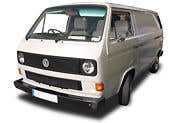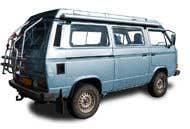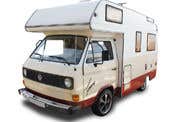History of the Volkswagen T25
Introduction
First built in August 1979, the T25, also known in the USA as a Vanagon, and in Germany and the majority of Europe as a T3, was a huge success and a radical jump forward from the evolution between Splitscreen and Bay Window Campers and Transporters.
 As you will be able to read below, by the end of production, the humble 1979, 1600cc CT model was replaced by a fuel injected 2100cc DJ unit and the practical, but not great, off road 2 wheel drive configuration was available as a four wheel drive (4x4) model known as a Syncro. The Syncro had a very respectable set of gearboxes and running gear produced in Austria by Puch. The syncro was available in 14 inch and 16 inch wheel sizes. As with the 2 wheel drive version, it could be ordered as a van, window van, microbus, Caravelle, Carat delux microbus, single cab pickup, double cab pickup and even in mid and high top versions, as well as a VW approved camping version made by Westfalia in Germany.
As you will be able to read below, by the end of production, the humble 1979, 1600cc CT model was replaced by a fuel injected 2100cc DJ unit and the practical, but not great, off road 2 wheel drive configuration was available as a four wheel drive (4x4) model known as a Syncro. The Syncro had a very respectable set of gearboxes and running gear produced in Austria by Puch. The syncro was available in 14 inch and 16 inch wheel sizes. As with the 2 wheel drive version, it could be ordered as a van, window van, microbus, Caravelle, Carat delux microbus, single cab pickup, double cab pickup and even in mid and high top versions, as well as a VW approved camping version made by Westfalia in Germany.
10 useful facts about the T25 (T3)
- The washer bottle is refilled by lifting the cab mat up, where you will find the washer bottle cap.
- To top up the brake fluid and on post 1981 versions, clutch fluid, you will need to remove the black cover to the instrument panels. But be careful, if you are a bit rough, the plastic tags holding the assembly to the dashboard break off!
- On a 2 wheel drive model, both petrol and diesel versions, the fuel tank is at the front (reassuringly straight under the drivers and passengers seats!) Because it has a concave top to the tank, mud and dirt can sit on the top of the tank and rust it out. Worth keeping an eye on.
- German produced vehicles post August 1985 were dip treated in the factory for rust prevention.
- If you have air in the water-cooled petrol or diesel models cooling system, it can cause them to overheat. To bleed out the system the front of the vehicle needs to be 30 to 45 cms higher than the rear (take care jacking up vehicles). The bleed valve is behind the grill.
- The Westfalia models with an elevating roof use the original hole that was designed for the metal ‘tilt and slide’ sunroof and is by far the strongest model of camper with an elevating roof.
- The last South African produced transporters came with a 5-cylinder petrol engine that in Europe was fitted to the Passat and Audi 80.
- The 1900cc and 2100cc water-cooled petrol engines are very ‘fussy’ about what antifreeze you use. If you use a run of the mill antifreeze, it can corrode the head studs in a very short number of months, causing all sorts of issues, including loss of power, water leaks into the bores etc. Always use the correct fluid like the J10916, which is made by FEBI in Germany to VW’s original specification.
- Porsche has created a version of the VW Transporter, but called it a B32, it was built as a limited edition. The van was equipped with 3.2 liter Carrera engine and was originally developed as a support vehicle for the Porsche 959, which took part in Paris-Dakar race.
- Lastly, a regular call to JK staff is “how do I check and fill up the oil on my T25?” There’s a flap behind the rear number plate. Pull the tag and all will be revealed…
Production history and technical updates
May 1979 Hanover built the first models of the ‘third’ generation Volkswagen Transporter. It was a total redesign of the old Bay Window, being wider with larger windows and tailgate, and a new front style. Very little was carried over from the previous model. There was new suspension, which moved away from the torsion bar system. Powered by either a 1600cc 50bhp (37kw) or 2000cc 70bhp (51kw) air-cooled engine.
February 1981 Introduction of a water-cooled 1600cc diesel engine with 50bhp (37kw). This engine originally came from the Golf.
September 1981 Introduction of the Caravelle, offering a more luxurious interior.
October 1981 Saw the first water-cooled flat four petrol engines in two versions: DF 1900cc 60bhp (44kw) and DG 1900cc 78bhp (57kw). Rear air intakes became plastic inserts.
1982 End of production of air-cooled engined models in Germany.
August 1983 Introduction of a higher spec ‘Caravelle’ with the option of a 4 lamp square grille.
 1985 The year of a full ‘revamp’ of the model. Changes included new exhaust systems, front suspension, sliding door locks, fuel injection systems, to name but a few. It is said over 1000 changes were made in this year alone. 1985 also saw the introduction of the Syncro, a four wheel drive vehicle, which was built with Steyr/Daimler/Puch in Austria. Capable of climbing a 54% gradient utilizing a center viscous coupling.
1985 The year of a full ‘revamp’ of the model. Changes included new exhaust systems, front suspension, sliding door locks, fuel injection systems, to name but a few. It is said over 1000 changes were made in this year alone. 1985 also saw the introduction of the Syncro, a four wheel drive vehicle, which was built with Steyr/Daimler/Puch in Austria. Capable of climbing a 54% gradient utilizing a center viscous coupling.
1986 ...Onwards vehicles did not suffer so badly with rust as a result of a new rust treatment in the production process.
September 1990 The last T25 left the Hanover factory, however production carried on in South Africa until the end of 2002. The last Syncro was built in 1992.
Type 25 chassis numbers
The chassis number, also known as the VIN, can be found stamped inside the offside door pillar. Find the 10th digit of the VIN (Vehicle Identification Number) and, using the table below, this digit will give you the model year. Please note that the build dates run from August to July not January to December, so for example a 1981 model could have been built in late 1980.
The last 6 digits are the serial nos.
| 10th digit | Model year | Build date |
|---|---|---|
| A | 1980 | 1st Aug 79 > 31st Jul 80 |
| B | 1981 | 1st Aug 80 > 31st Jul 81 |
| C | 1982 | 1st Aug 81 > 31st Jul 82 |
| D | 1983 | 1st Aug 82 > 31st Jul 83 |
| E | 1984 | 1st Aug 83 > 31st Jul 84 |
| F | 1985 | 1st Aug 84 > 31st Jul 85 |
| G | 1986 | 1st Aug 85 > 31st Jul 86 |
| H | 1987 | 1st Aug 86 > 31st Jul 87 |
| J | 1988 | 1st Aug 87 > 31st Jul 88 |
| K | 1989 | 1st Aug 88 > 31st Jul 89 |
| L | 1990 | 1st Aug 89 > 31st Jul 90 |
| M | 1991 | 1st Aug 90 > 31st Jul 91 |
| N | 1992 | 1st Aug 91 > 31st Jul 92 |
Type 25 engine specifications
- 1600cc air-cooled
- 2000cc air-cooled
- 1900 > 2100cc water-cooled
- 1600 > 1700cc diesel and turbo diesel
T25 engine numbers
This can be found stamped on the top of the crankcase, centrally above the crankshaft pulley/fan on all petrol engines, and also stamped on the engine block between the injection pump and vacuum pump on all diesels.
| CODE | CC | BHP | NOTES |
|---|---|---|---|
| 1600cc air-cooled | |||
| CT | 1600cc | 50 bhp | Flat 4 |
| 2000cc air-cooled | |||
| CU | 2000cc | 70 bhp | Flat 4 |
| CV | 2000cc | 70 bhp | Flat 4 |
| 1900>2100cc water-cooled | |||
| EY | 1900cc | 55 bhp | Flat 4 |
| DF | 1900cc | 60 bhp | Flat 4 |
| SP | 1900cc | 73 bhp | Flat 4 |
| DG | 1900cc | 78 bhp | Flat 4 |
| DH | 1900cc | 83 bhp | Flat 4 |
| GW | 1900cc | 90 bhp | Flat 4 |
| SR | 2100cc | 87 bhp | Flat 4 |
| SS | 2100cc | 92 bhp | Flat 4 |
| MV | 2100cc | 95 bhp | Flat 4 |
| DJ | 2100cc | 112 bhp | Flat 4 |
| 1600>1700cc diesel and turbo diesel | |||
| CS | 1600cc | 50 bhp | Inline 4 |
| KY | 1700cc | 57 bhp | Inline 4 |
| JX | 1600cc | 70 bhp | Inline 4 |

Type 25 paint codes
Please note, most of the versions sold as “Campers” started out as vans or microbuses and were converted by companies such as Viking, Devon and Bilbos. They very often painted the bottom half to give it a distinctive 2 tone look, but almost certainly not using original VW colours! JK supply a wide range of camper interior parts for conversion and restoration. Paint code information is correct to the best of our knowledge, however, we accept no responsibility for erroneous information.
| LH8B | Assuan Brown |
| L86Z | Agate Brown |
| LA8A | Marian Brown |
| LH8B | Mocca Brown |
| L90D | Pastel White |
| LH9D | Damuso White |
| L567 | Ivory |
| LP7Y | Flash Silver Metallic |
| LH7V | Wolfram Grey Metallic |
| LB7Y | Vesuve Grey Metallic |
| L20B | Black |
| LH1N | Samos Beige |
| LH8T | Timor Beige |
| LH8U | Bronze Beige Metallic |
| LH1V | Savannah Beige Metallic |
| LL1M | Beige |
| LA1N | Nevada Beige |
| LT6A | Escorial Green |
| LH5H | Cornat Blue |
| LY5B | Copenhagen Blue |
| LH5K | Guinea Blue |
| LH5G | Medium Blue |
| LA5D | Monaco Blue |
| LH5T | Kuril Blue |
| LH5U | Dove Blue Metallic |
| LA5B | Marine Blue |
| LK5E | Capri Blue |
| LP5Z | Orly Blue Metallic |
| LH1B | Bamboo Yellow |
| L20B | Brilliant Orange |
| LH3D | Marsala Red |
| LB3V | Titan Red Metallic |
| LC3Y | Bordeaux Red Metallic |
| LY3D | Tornado Red |
Shop more than 1,100 Volkswagen T25 parts and accessories here...
History of the Volkswagen T25


The Volkswagen T25 / T3
Introduction
First built in August 1979, the T25, also known in the USA as a Vanagon, and in Germany and the majority of Europe as a T3, was a huge success and a radical jump forward from the evolution between Splitscreen and Bay Window Campers and Transporters.
As you will be able to read below, by the end of production, the humble 1979, 1600cc CT model was replaced by a fuel injected 2100cc DJ unit and the practical, but not great, off road 2 wheel drive configuration was available as a four wheel drive (4x4) model known as a Syncro. The Syncro had a very respectable set of gearboxes and running gear produced in Austria by Puch. The syncro was available in 14 inch and 16 inch wheel sizes. As with the 2 wheel drive version, it could be ordered as a van, window van, microbus, Caravelle, Carat delux microbus, single cab pickup, double cab pickup and even in mid and high top versions, as well as a VW approved camping version made by Westfalia in Germany.
Main variants of the T25 (T3)
Panel van, with 1 or 2 sliding doors
Single cab pickup
Double cab pickup (DoKa)
Microbus. Features 3 rows of seats and a low spec interior
Caravelle. Features 3 rows of seats and a high spec interior
Syncro 14"". Features 4x4 transmission
Syncro 16"". An even tougher 4x4 model.
The T25 ’Campers’ were converted by various companies. Some, such as Westfalia, used a Microbus as the base vehicle while many others used the cheaper panel van as a starting point.
Quick Identification


Air-cooled models have a single grille by the headlamps.


Water-cooled (Petrol or diesel) versions have two grilles. one by the headlamps and a second lower down by the indicators.
10 useful facts about the T25 (T3)
- The washer bottle is refilled by lifting the cab mat up, where you will find the washer bottle cap.
- To top up the brake fluid and on post-1981 versions, clutch fluid, you will need to remove the black cover to the instrument panels. But be careful, if you are a bit rough, the plastic tags holding the assembly to the dashboard break off!
- On a 2-wheel drive model, both petrol and diesel versions, the fuel tank is at the front (reassuringly straight under the driver's and passengers' seats!) Because it has a concave top to the tank, mud and dirt can sit on the top of the tank and rust it out. Worth keeping an eye on.
- German-produced vehicles post-August 1985 were dip treated in the factory for rust prevention.
- If you have air in the water-cooled petrol or diesel models' cooling system, it can cause them to overheat. To bleed out the system the front of the vehicle needs to be 30 to 45 cm higher than the rear (take care jacking up vehicles). The bleed valve is behind the grill.
- The Westfalia models with an elevating roof use the original hole that was designed for the metal ‘tilt and slide’ sunroof and is by far the strongest model of camper with an elevating roof.
- The last South African-produced transporters came with a 5-cylinder petrol engine that in Europe was fitted to the Passat and Audi 80.
- The 1900cc and 2100cc water-cooled petrol engines are very ‘fussy’ about what antifreeze you use. If you use a run of the mill antifreeze, it can corrode the head studs in a very short number of months, causing all sorts of issues, including loss of power, water leaks into the bores etc. Always use the correct fluid like the J10916, which is made by FEBI in Germany to VW’s original specification.
- Porsche has created a version of the VW Transporter, but called it a B32, it was built as a limited edition. The van was equipped with a 3.2 litre Carrera engine and was originally developed as a support vehicle for the Porsche 959, which took part in the Paris-Dakar race.
- Lastly, a regular call to JK staff is “How do I check and fill up the oil on my T25?” There’s a flap behind the rear number plate. Pull the tag and all will be revealed…
Production history and model development
- May 1979 Hanover built the first models of the ‘third’ generation Volkswagen Transporter. It was a total redesign of the old Bay Window, being wider with larger windows and tailgate, and a new front style. Very little was carried over from the previous model. There was new suspension, which moved away from the torsion bar system. Powered by either a 1600cc 50bhp (37kw) or 2000cc 70bhp (51kw) air-cooled engine.
- February 1981 Introduction of a water-cooled 1600cc diesel engine with 50bhp (37kw). This engine originally came from the Golf.
- September 1981 Introduction of the Caravelle, offering a more luxurious interior.
- October 1981 Saw the first water-cooled flat four petrol engines in two versions: DF 1900cc 60bhp (44kw) and DG 1900cc 78bhp (57kw). Rear air intakes became plastic inserts.
- 1982 End of production of air-cooled engined models in Germany.
- August 1983 Introduction of a higher spec ‘Caravelle’ with the option of a 4 lamp square grille.
- 1985 The year of a full ‘revamp’ of the model. Changes included new exhaust systems, front suspension, sliding door locks, fuel injection systems, to name but a few. It is said over 1000 changes were made in this year alone. 1985 also saw the introduction of the Syncro, a four wheel drive vehicle, which was built with Steyr/Daimler/Puch in Austria. Capable of climbing a 54% gradient utilizing a center viscous coupling.
- 1986 ...Onwards vehicles did not suffer so badly with rust as a result of a new rust treatment in the production process.
- September 1990 The last T25 left the Hanover factory, however production carried on in South Africa until the end of 2002. The last Syncro was built in 1992.
Type 25 chassis numbers
The chassis number, also known as the VIN, can be found stamped inside the offside door pillar. Find the 10th digit of the VIN (Vehicle Identification Number) and, using the table below, this digit will give you the model year. Please note that the build dates run from August to July not January to December, so for example a 1981 model could have been built in late 1980.
The last 6 digits are the serial nos.
10th digit Model year Build date
A 1980 1st Aug 79 > 31st Jul 80
B 1981 1st Aug 80 > 31st Jul 81
C 1982 1st Aug 81 > 31st Jul 82
D 1983 1st Aug 82 > 31st Jul 83
E 1984 1st Aug 83 > 31st Jul 84
F 1985 1st Aug 84 > 31st Jul 85
G 1986 1st Aug 85 > 31st Jul 86
H 1987 1st Aug 86 > 31st Jul 87
J 1988 1st Aug 87 > 31st Jul 88
K 1989 1st Aug 88 > 31st Jul 89
L 1990 1st Aug 89 > 31st Jul 90
M 1991 1st Aug 90 > 31st Jul 91
N 1992 1st Aug 91 > 31st Jul 92
Type 25 engine specifications
1600cc air-cooled
2000cc air-cooled
1900 > 2100cc water-cooled
1600 > 1700cc diesel and turbo diesel
T25 engine numbers
This can be found stamped on the top of the crankcase, centrally above the crankshaft pulley/fan on all petrol engines, and also stamped on the engine block between the injection pump and vacuum pump on all diesels.
CODE CC BHP NOTES
1600cc Air-Cooled
CT 1600cc 50 bhp Flat 4
2000cc Air-Cooled
CU 2000cc 70 bhp Flat 4
CV 2000cc 70 bhp Flat 4
1900>2100cc Water-Cooled
EY 1900cc 55 bhp Flat 4
DF 1900cc 60 bhp Flat 4
SP 1900cc 73 bhp Flat 4
DG 1900cc 78 bhp Flat 4
DH 1900cc 83 bhp Flat 4
GW 1900cc 90 bhp Flat 4
SR 2100cc 87 bhp Flat 4
SS 2100cc 92 bhp Flat 4
MV 2100cc 95 bhp Flat 4
DJ 2100cc 112 bhp Flat 4
1600>1700cc Diesel and Turbo Diesel
CS 1600cc 50 bhp Inline 4
KY 1700cc 57 bhp Inline 4
JX 1600cc 70 bhp Inline 4
Type 25 paint codes
Please note, most of the versions sold as “Campers” started out as vans or microbuses and were converted by companies such as Viking, Devon and Bilbos. They very often painted the bottom half to give it a distinctive 2 tone look, but almost certainly not using original VW colours! JK supply a wide range of camper interior parts for conversion and restoration. Paint code information is correct to the best of our knowledge, however, we accept no responsibility for erroneous information.
LH8B Assuan Brown
L86Z Agate Brown
LA8A Marian Brown
LH8B Mocca Brown
L90D Pastel White
LH9D Damuso White
L567 Ivory
LP7Y Flash Silver Metallic
LH7V Wolfram Grey Metallic
LB7Y Vesuve Grey Metallic
L20B Black
LH1N Samos Beige
LH8T Timor Beige
LH8U Bronze Beige Metallic
LH1V Savannah Beige Metallic
LL1M Beige
LA1N Nevada Beige
LT6A Escorial Green
LH5H Cornat Blue
LY5B Copenhagen Blue
LH5K Guinea Blue
LH5G Medium Blue
LA5D Monaco Blue
LH5T Kuril Blue
LH5U Dove Blue Metallic
LA5B Marine Blue
LK5E Capri Blue
LP5Z Orly Blue Metallic
LH1B Bamboo Yellow
L20B Brilliant Orange
LH3D Marsala Red
LB3V Titan Red Metallic
LC3Y Bordeaux Red Metallic
LY3D Tornado Red




